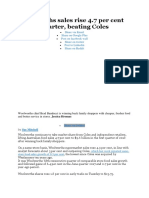Module 8 - The Global Financial Crisis
Module 8 - The Global Financial Crisis
Uploaded by
AmiteshCopyright:
Available Formats
Module 8 - The Global Financial Crisis
Module 8 - The Global Financial Crisis
Uploaded by
AmiteshOriginal Title
Copyright
Available Formats
Share this document
Did you find this document useful?
Is this content inappropriate?
Copyright:
Available Formats
Module 8 - The Global Financial Crisis
Module 8 - The Global Financial Crisis
Uploaded by
AmiteshCopyright:
Available Formats
Module 8 – The Global Financial Crisis 1
Module 8 – The Global Financial Crisis
Introduction
The Global Financial Crisis (GFC), which started in August 2007, arose from a much higher
than expected default rate on sub-prime debt (i.e. loans made to borrowers with low credit
standings). It led to defaults by banks, investment banks and other investment vehicles. These
developments were global because securities based on the sub-prime debt were distributed
across the world. The current global financial crisis (GFC) has been compared to the Great
Depression of the 1930s. Some economists such as Paul Krugman view the current crisis as
being milder than the Great Depression basing their opinions on the relative fall in US
industrial production compared to the late-2007 peak. Other economists, most notably
Eichengreen and O’Rourke (2009) take a global perspective and view the current crisis as
comparable to the Great Depression if not worse. Although the crisis originated in the
financial sector, it affected major stock markets around the globe, typically losing close to
half of their value.
Learning objectives
On completion of this module students will be:
● understand the origins of the Global Financial Crisis which began in August 2007
● understand the factors that contributed to the GFC
● understand the impact of GFC on economies around the world
● understand the various stages of a financial crisis and the role of asymmetric information.
Resources
Text
Mishkin, FS & Eakins, SG 2012, Financial markets and institutions, 7th edn, Pearson
Education Limited, Edinburgh Gate, England (chapter 8).
Valentine, T, Ford, G, O’Hara, L & Sundmacher, M 2011, Fundamentals of financial markets
and institutions in Australia, Pearson, Frenchs Forest, New South Wales (chapter 12).
Note: This material is contained in module 8 of your custom publication: FIN8202 Financial
markets and instruments.
© University of Southern Queensland
2 FIN8202 – Financial markets and instruments
8.1 Key concepts
The Global Financial Crisis (GFC) arose from high levels of defaults on sub-prime debt
(loans to lower credit rates borrowers) which largely originated in the United States and
which was distributed around the world in the form of wholesale asset-backed securities.
Such securities were often called CDOs (collateralised debt obligations).
The GFC led to a ‘credit crunch’ which is a reduction in banks willingness to lend because
of:
● losses which forced the banks to re-establish their capital positions
● mistrust of the solvency of borrowers, including other banks.
A credit default swap (CDS) is an over-the-counter derivative which compensates lenders for
losses on loans. They are often provided by hedge funds which are highly leveraged funds
(i.e. their investment portfolios are larger than the amount contributed by their investors) and
often located in tax havens.
A special purpose vehicle (SPV) is the entity which buys loans and repackages them into
large denomination securities.
8.2 Factors contributing to GFC
The factors contributing to the GFC included:
a. Globalisation which refers to the integration of national financial sectors and economies
is a contributing factor. This integration arose from the deregulation of domestic financial
sectors, a removal of capital controls and the reduction of trade barriers. The effect of
globalisation was to facilitate the distribution of sub-prime (also called toxic) debt around
the world.
b. A global imbalance between countries with a high saving ratio (such as China, Japan and
Germany) and those with low or negative savings (such as the US, the UK and Australia).
The former have current account surpluses whereas the latter have current account
deficits. These surpluses and deficits allow funds to be transferred from countries with
high saving to countries with high borrowing. This process supported the high borrowing.
Correction of this imbalance requires both sides to change their behaviour.
c. Related to (b), there was a fall in the saving ratio in most Western nations. One reason for
this fall was the increased ease of borrowing in these countries.
d. Credit standards declined in many Western countries, particularly the United States. As
the GFC originated in the United States, it is reasonable to concentrate on that country.
Standards declined because:
● Political pressures encouraged lending to low–income borrowers who did not
previously qualify for loans. This approach was seen as an anti-discrimination device.
● Regulatory failures allowed the emergence of sub-prime lending which included lo-
doc/no-doc loans in which borrowers were not required to reveal their credit history,
© University of Southern Queensland
Module 8 – The Global Financial Crisis 3
assets, job situation or even verify their identities. This led to ‘liars’ loans’ and loans
to NINJA’S – no income, no job, no assets.
● Interest rates were kept at very low levels. Part of this was the ‘Greenspan Put’ in
which the head of the US Federal Reserve Board ensured the value of assets by
following a low interest rate policy. Lenders also offered initially low interest rates –
‘honeymoon or teaser’ rates.
● Mortgage loans are non-recourse in many US states, i.e. lenders have a claim only
against the home and have no residual claim against the borrower.
The toxic debt was repackaged into large denomination mortgage backed bonds by Special
Purpose Vehicles (SPVs) who purchased it from the original lenders. It was:
● provided with credit enhancements such as mortgage insurance or a credit default swap
(CDS)
● provided with a credit rating by one of the rating agencies.
Paper rated AAA could be sold to institutional investors such as pension (superannuation)
funds and local government authorities. These investors suffered losses when defaults turned
out to be well above the historical average.
Policies to deal with the GFC included:
● fiscal stimulus aimed at offsetting the economic downturns arising from the GFC
● financial re-regulation including tighter controls on banks and other financial institutions
and regulation of credit default swaps. Little has been done to regulate lending and to
raise credit standards.
8.3 The different stages of a financial crisis
The different stages of a financial crises are outlined in the diagram below. The underlying
causes of a financial crisis is best understood using the concepts of agency theory, and
asymmetric information (adverse selection and moral hazard). Agency theory is used to
outline the six factors that play key roles in financial crises.
Asymmetric information could potentially result in two problems: adverse selection and
moral hazard. Adverse selection which occurs before the transaction may be illustrated by the
fact that borrowers with bad credit risks are more likely to seek loans than those with good
credit risk. Moral hazard which occurs after the transaction may be explained by the
potentially undesirable behaviour of borrowers engaging in activities that adversely affect the
lenders.
During the period leading up to the GFC agency problems in mortgage markets also reached
new levels:
● Mortgage originators did not hold the actual mortgage, but sold the note in the secondary
market.
● Mortgage originators earned fees from the volume of the loans produced, not the quality.
© University of Southern Queensland
4 FIN8202 – Financial markets and instruments
● In the extreme, unqualified borrowers bought houses they could not afford through either
creative mortgage products or outright fraud (such as inflated income).
Some of the behavior of rating agencies exacerbated the crisis:
● Agencies consulted with firms on structuring products to achieve the highest rating,
creating a clear conflict.
● Further, the rating system was hardly designed to address the complex nature of the
structured debt designs.
● The result was meaningless ratings that investors had relied on to assess the quality of
their investments.
Figure 1: Sequence of events in emerging market financial crises
(Note: the arrows trace the sequence of events during financial crises.)
(Source: Mishkin & Eakins 2012)
© University of Southern Queensland
Module 8 – The Global Financial Crisis 5
Self assessment 1
Revision questions 1, 5, 6, 7, 8, 9, 10 & 11 from Valentine et al., chapter 12.
Questions 1, 4, 5, 6, 9 & 10; Quantitative problem 2 from Mishkin & Eakins,
chapter 8.
Answers are in the solutions manual.
Additional self-assessment
Weekly tutorial worksheet – see USQStudyDesk.
Conclusion
Financial crises are inherently interesting because they are so dramatic. This has become even
more true with the recent 2007–2009 Financial Crisis, which Alan Greenspan characterized
as a once-in-a-century credit tsunami.
References
Krugman, P 2009, ‘The great recession versus the great depression’, The New York Times,
20 March, viewed 1 March 2011, <http://krugman.blogs.nytimes.com/2009/03/20/the-great-
recession-versus-the-great-depression/>.
Eichengreen, B & O’Rourke, K. 2009, A tale of two depressions, viewed 6 April 2009,
<http://www.voxeu.org/index.php?q=node/3421>.
© University of Southern Queensland
You might also like
- The Subtle Art of Not Giving a F*ck: A Counterintuitive Approach to Living a Good LifeFrom EverandThe Subtle Art of Not Giving a F*ck: A Counterintuitive Approach to Living a Good LifeRating: 4 out of 5 stars4/5 (5935)
- The Gifts of Imperfection: Let Go of Who You Think You're Supposed to Be and Embrace Who You AreFrom EverandThe Gifts of Imperfection: Let Go of Who You Think You're Supposed to Be and Embrace Who You AreRating: 4 out of 5 stars4/5 (1106)
- Never Split the Difference: Negotiating As If Your Life Depended On ItFrom EverandNever Split the Difference: Negotiating As If Your Life Depended On ItRating: 4.5 out of 5 stars4.5/5 (879)
- Grit: The Power of Passion and PerseveranceFrom EverandGrit: The Power of Passion and PerseveranceRating: 4 out of 5 stars4/5 (598)
- Hidden Figures: The American Dream and the Untold Story of the Black Women Mathematicians Who Helped Win the Space RaceFrom EverandHidden Figures: The American Dream and the Untold Story of the Black Women Mathematicians Who Helped Win the Space RaceRating: 4 out of 5 stars4/5 (925)
- Shoe Dog: A Memoir by the Creator of NikeFrom EverandShoe Dog: A Memoir by the Creator of NikeRating: 4.5 out of 5 stars4.5/5 (545)
- The Hard Thing About Hard Things: Building a Business When There Are No Easy AnswersFrom EverandThe Hard Thing About Hard Things: Building a Business When There Are No Easy AnswersRating: 4.5 out of 5 stars4.5/5 (353)
- Elon Musk: Tesla, SpaceX, and the Quest for a Fantastic FutureFrom EverandElon Musk: Tesla, SpaceX, and the Quest for a Fantastic FutureRating: 4.5 out of 5 stars4.5/5 (476)
- Her Body and Other Parties: StoriesFrom EverandHer Body and Other Parties: StoriesRating: 4 out of 5 stars4/5 (831)
- The Emperor of All Maladies: A Biography of CancerFrom EverandThe Emperor of All Maladies: A Biography of CancerRating: 4.5 out of 5 stars4.5/5 (274)
- The Little Book of Hygge: Danish Secrets to Happy LivingFrom EverandThe Little Book of Hygge: Danish Secrets to Happy LivingRating: 3.5 out of 5 stars3.5/5 (419)
- The World Is Flat 3.0: A Brief History of the Twenty-first CenturyFrom EverandThe World Is Flat 3.0: A Brief History of the Twenty-first CenturyRating: 3.5 out of 5 stars3.5/5 (2271)
- The Yellow House: A Memoir (2019 National Book Award Winner)From EverandThe Yellow House: A Memoir (2019 National Book Award Winner)Rating: 4 out of 5 stars4/5 (99)
- Devil in the Grove: Thurgood Marshall, the Groveland Boys, and the Dawn of a New AmericaFrom EverandDevil in the Grove: Thurgood Marshall, the Groveland Boys, and the Dawn of a New AmericaRating: 4.5 out of 5 stars4.5/5 (270)
- The Sympathizer: A Novel (Pulitzer Prize for Fiction)From EverandThe Sympathizer: A Novel (Pulitzer Prize for Fiction)Rating: 4.5 out of 5 stars4.5/5 (122)
- Team of Rivals: The Political Genius of Abraham LincolnFrom EverandTeam of Rivals: The Political Genius of Abraham LincolnRating: 4.5 out of 5 stars4.5/5 (235)
- A Heartbreaking Work Of Staggering Genius: A Memoir Based on a True StoryFrom EverandA Heartbreaking Work Of Staggering Genius: A Memoir Based on a True StoryRating: 3.5 out of 5 stars3.5/5 (232)
- Exam Practice Answers : Version ADocument38 pagesExam Practice Answers : Version AAmitesh67% (3)
- Cpa Australia Taxation Study GuideDocument1 pageCpa Australia Taxation Study GuideAmiteshNo ratings yet
- On Fire: The (Burning) Case for a Green New DealFrom EverandOn Fire: The (Burning) Case for a Green New DealRating: 4 out of 5 stars4/5 (75)
- English For The Financial Sector Intermediate Teachers Book FrontmatterDocument10 pagesEnglish For The Financial Sector Intermediate Teachers Book FrontmatterPS Lee0% (3)
- The Unwinding: An Inner History of the New AmericaFrom EverandThe Unwinding: An Inner History of the New AmericaRating: 4 out of 5 stars4/5 (45)
- CAANZ Covid19-ART PDFDocument40 pagesCAANZ Covid19-ART PDFAmiteshNo ratings yet
- Admin Service - Duty Travel - Daily Subsistence Allowance (DSA)Document9 pagesAdmin Service - Duty Travel - Daily Subsistence Allowance (DSA)AmiteshNo ratings yet
- How To Maximise The Value of Your Tower AssetsDocument16 pagesHow To Maximise The Value of Your Tower AssetsAmiteshNo ratings yet
- Ethics and Governance: Tutor Material Module 1: Accounting and SocietyDocument32 pagesEthics and Governance: Tutor Material Module 1: Accounting and SocietyAmiteshNo ratings yet
- Indias Satyam Accounting Scandal How The PDFDocument13 pagesIndias Satyam Accounting Scandal How The PDFAmiteshNo ratings yet
- Cost Models - ParcusDocument28 pagesCost Models - ParcusAmitesh100% (1)
- Women in Leadership Training DatabaseDocument2 pagesWomen in Leadership Training DatabaseAmiteshNo ratings yet
- SIM & Recharge 120 Bedsheets 10 Breakfast 16.4 Lunch 40.7 Dinner 37.6 Vegetables 67.5 Miscellaneous 12.54Document1 pageSIM & Recharge 120 Bedsheets 10 Breakfast 16.4 Lunch 40.7 Dinner 37.6 Vegetables 67.5 Miscellaneous 12.54AmiteshNo ratings yet
- Revenue From Contracts With Customers: Global EditionDocument283 pagesRevenue From Contracts With Customers: Global EditionAmitesh100% (1)
- BF - Fourmulae - 2013Document3 pagesBF - Fourmulae - 2013AmiteshNo ratings yet
- Woolworths Sales Rise 4Document7 pagesWoolworths Sales Rise 4AmiteshNo ratings yet
- Eilifsen Sample Chapter PDFDocument28 pagesEilifsen Sample Chapter PDFAmiteshNo ratings yet
- Test Bnak For Auditing A Practical Approach Extended Canadian Edition by Robyn MoroneyDocument23 pagesTest Bnak For Auditing A Practical Approach Extended Canadian Edition by Robyn MoroneyAmiteshNo ratings yet
- Internship Report (Final) SBLDocument4 pagesInternship Report (Final) SBLAshraf Uddin AhmedNo ratings yet
- Banker As LenderDocument19 pagesBanker As Lendervanishachhabra5008No ratings yet
- Vimal Dairy MbaDocument81 pagesVimal Dairy MbaViral Chaudhari0% (1)
- EBL Internship ReportDocument59 pagesEBL Internship ReportRiyad AhsanNo ratings yet
- OTC Derivatives SettlementsDocument3 pagesOTC Derivatives Settlementsanon_909322234No ratings yet
- Executive Summary: K M F DDocument47 pagesExecutive Summary: K M F DUmesh AllannavarNo ratings yet
- Credit Guarantee Policy DocumentDocument10 pagesCredit Guarantee Policy Documentchaka2002No ratings yet
- Report On Debt ManagementDocument79 pagesReport On Debt ManagementSiddharth Mehta100% (1)
- The American Jobs Act of 2011'' Legislative ProposalDocument206 pagesThe American Jobs Act of 2011'' Legislative ProposalFedScoopNo ratings yet
- CREDIT RISK AND COMMERCIAL BANKS' PERFORMANCE IN NIGERIA: A PANEL Model APPROACHDocument8 pagesCREDIT RISK AND COMMERCIAL BANKS' PERFORMANCE IN NIGERIA: A PANEL Model APPROACHdarkniightNo ratings yet
- Philip Daniel Lopez: Executive SummaryDocument2 pagesPhilip Daniel Lopez: Executive SummaryDannyLopezNo ratings yet
- OWWA Loan ExplainedDocument17 pagesOWWA Loan ExplainedPéddiéGréiéNo ratings yet
- Bedt Prsctices in Slum Improvement BrazilDocument41 pagesBedt Prsctices in Slum Improvement BrazilSuraj KumarNo ratings yet
- Credit InsuranceDocument56 pagesCredit InsuranceVineetaNo ratings yet
- Lyn Thomas-BookDocument85 pagesLyn Thomas-BookmustafahashimkhaskheNo ratings yet
- CIB OnlineDocument22 pagesCIB OnlineRejaul KarimNo ratings yet
- Excel Cash Book Extra RowsDocument28 pagesExcel Cash Book Extra RowsppjobNo ratings yet
- What Is International TradeDocument2 pagesWhat Is International Tradeeknath2000No ratings yet
- The Opium Economy in Afghanistan (2003)Document226 pagesThe Opium Economy in Afghanistan (2003)marxbertNo ratings yet
- ch14-Off-Balance Sheet ActivitiesDocument15 pagesch14-Off-Balance Sheet ActivitiesYousif Agha100% (3)
- Straw ManDocument48 pagesStraw ManSilverBaron0% (1)
- The Lending Process: Step-By-Step Name of Client: - Days To Complete Date Completed Identification of New CustomersDocument3 pagesThe Lending Process: Step-By-Step Name of Client: - Days To Complete Date Completed Identification of New CustomersShubham ParmarNo ratings yet
- BOI Saral Salary Account SchemeDocument3 pagesBOI Saral Salary Account SchemeLakshmi NarasaiahNo ratings yet
- 1604133570Document137 pages1604133570Rashmi HasrajaniNo ratings yet
- Working Capital ManagementDocument59 pagesWorking Capital Managementsush_pande08No ratings yet
- EntrepreneurshipDocument4 pagesEntrepreneurshipSukriti MandalNo ratings yet
- Finance Broker Ebook PDFDocument224 pagesFinance Broker Ebook PDFRadomir Popović100% (2)
- Source: Annual Accounts of BanksDocument6 pagesSource: Annual Accounts of BanksARVIND YADAVNo ratings yet
- OBLICON LabitagDocument52 pagesOBLICON LabitagCrizza CozNo ratings yet





















































































